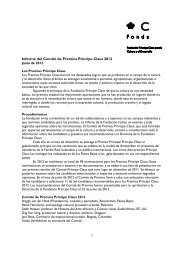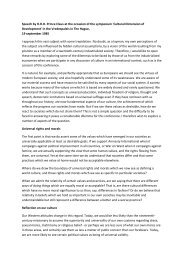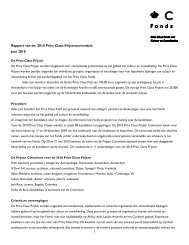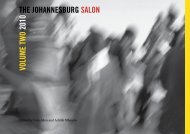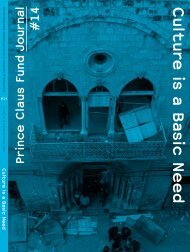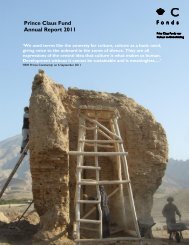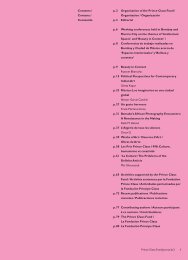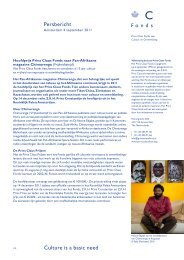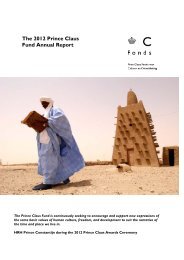30r364 boek.qxd:awards book 11 - Prince Claus Fund
30r364 boek.qxd:awards book 11 - Prince Claus Fund
30r364 boek.qxd:awards book 11 - Prince Claus Fund
You also want an ePaper? Increase the reach of your titles
YUMPU automatically turns print PDFs into web optimized ePapers that Google loves.
Through the Cracks of a Mirrorby Shahidul AlamIt is a moment etched in her mind. In a workshop with Eugene Richards, one of the greatest photo -journalists of our time, the participants were asked to “photograph each other naked”. Dayanitawas not comfortable with this, and questioned the value of such an exercise. “Trust me,” Eugenesaid, “I want you to realise how vulnerable one can be facing a camera.” It was to be a turning point.It was this ‘vulnerability’ that Dayanita Singh chose to explore through her medium.As a curator of ‘Positive Lives’ – an exhibition on people’s responses to HIV/AIDS – I was firstintroduced to Dayanita’s work through the archives of a respected Network Agency. I saw com pe tentphoto essays on sex workers in India. The work did not excite me. India was known for its exoticism,its misery, its otherness. An Indian photographer, documenting the same stories that westernphotojournalists had established as the face of this great nation, was a disappoint ment. But I couldhardly dispute the images. She was a fine photographer, and while the prints lacked the quality onemight have desired, the photographer was clearly one skilled in her art. That, for me, was not theissue. I was later to discover that it was not the issue for this remarkable photographer either.The images Dayanita subsequently produced for ‘Positive Lives’ were breathtaking. The exquisitecomposition and her sense of moment were the tactile elements that made her images stunning,but more persuasive was the humanity in her photographs. The tender relationships, the joy, theshared pain, the sense of belonging that she was able to nurture and portray. It was then that thetrouble started, a trouble that I am glad I came across. We had meticulously gone through the issuesof representing people with HIV/AIDS. The risks people faced due to stigma. The physical dangersthe display of the images might lead to. Dayanita’s concern for the people she had photo graphedmeant she had to protect them all the way. It was frustrating for me as a curator. To find that pictureswhich were sublime in their construction had to be left behind because the photo grapher felt therewas too great a risk of repercussion. Too great a threat, of perhaps things going wrong. We put to get -her a great show, but I knew, photographically, it could have been much greater. I also knew we haddone the right thing. Dayanita remembered too well, how vulnerable one could be facing a camera.I look back to the stroll through her flat in Delhi, the photographs taken by her mother, juxta -posed with her own. She had been questioning her own work for some time. Questioning her‘success’ at producing images that regurgitated the ‘India’ the west already knew. She chose tobecome a mirror to herself and, in that process, begin a journey that would create a window to aneveryday world. An everydayness that other photographers had shunned. Dayanita and her cameramerged into one. She became the fly on the wall, the confidant, the muse, the critic. Before subcontinentalliterature had made its indelible mark, Dayanita was writing visual novels about middleclassIndia. The glitzy, private, solemn, contradictory, celebratory world of the India today. Sheharnessed photography’s unique ability to record detail, its penchant for capturing the fleeting.Its ability to make time stand still. She made the ordinary, special, and the special, ordinary.She also made an important shift within the profession. Recognising that the medium hadshifted from the Life Magazine visual spectacles, aware that the spaces for visual journalism hadshifted, Dayanita took on spaces that other photographers had feared to tread. Her venture intomuseums and galleries, her indisputable presence as an artist, has challenged the trad i ti on alistsin the field of art, who had been unable to grasp the magic of this new medium. Her presence, whileimposing, is also path breaking. A new generation of photographers will wake up to this widercanvas. Some will explore this new space. And the ripples will spread. Dayanita meanwhile will con -tinue to nurture the vulnerable. Through the cracks of her mirror she will take us to the other side.822008 <strong>Prince</strong> <strong>Claus</strong> Awards



